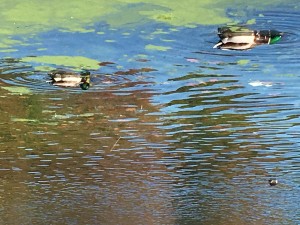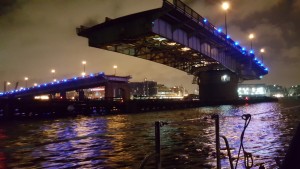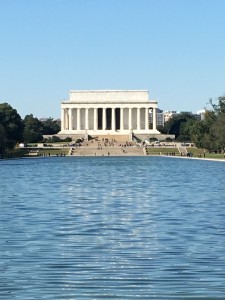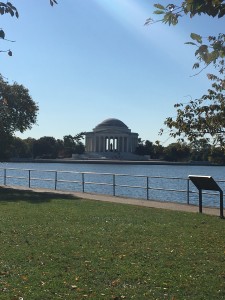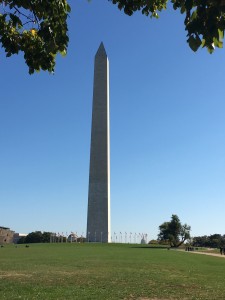“Together we can build a world we want, a world we’re proud to leave our children and grandchildren.” – Ban Ki-moon, United Nations Secretary-General
We sailed 96 miles up the Potomac River from Chesapeake Bay to the Navy Yard on the Anacostia River in Washington D.C. on October 22 and 23. And along the way, we saw Great Blue Herons posing as sticks along marshes and mud flats ever-ready to grab a meal with a quick lunge of their bill, Bald Eagles swooping down and snatching fish from the river with their talons, Mallards and
American Black ducks dabbling for dinner, and older generations of anglers sharing their love of fishing and connection to the water with younger family members and friends. A previous blog mentioned that people protect what they love; and these passionate fishermen plying the rivers and creeks of the Chesapeake watershed were certainly passing on to their children and grandchildren a love of fishing and a deeper connection to the Chesapeake and its wildlife – a relationship that will, hopefully, translate into a reason for future generations to protect these wild places for years to come. Have you shared time outdoors with someone you love today? Don’t underestimate its value…
Did you know that wetlands and saltwater estuaries are the most valuable types of landforms that exist on our planet? They are nature’s aquatic breeding grounds and are among the most productive ecosystems in the world – forming the base of the aquatic food web that feeds many species of fish amphibians, shellfish and insects; they filter and improve water quality; they provide fish and wildlife habitats; they absorb floodwaters, prevent shoreline erosion, and maintain surface water flow during dry periods; they store carbon within their plants and soil instead of releasing it to the atmosphere as carbon dioxide; they have recreation and aesthetic value that feeds our souls; and they provide untold economic benefits to coastal communities and to our national and global economies. Wetlands are more than cool; life, as we know it on planet Earth, depends upon them. Check out this site for 10 things you can do for coastal wetlands.
Sailing up the Potomac River, we had a 12 midnight deadline to meet on October 23 as we had pre-arranged for the city of D.C. to open the Frederick Douglass swing Bridge so that Tusen Takk could pass through on its way to the Yards Marina on the Anacostia River in the Navy Yard neighborhood, three miles upstream from where the Anacostia joins the Potomac. The bridge clearance is approximately 40 feet at high tide, and Tusen Takk has a mast height of 48 feet, hence the need for the late-night swing dance. The bridge is only opened once per month at midnight, so we were a bit anxious not to miss the appointment.
It was quite the adventure. Our plan was to cast off from the dock at James Creek Marina at 11:45 p.m. and head upstream for a mile trek to the bridge. As we cast off, however, the wind started to blow 20 knots with 30 mph gusts blowing us back onto the dock in pelting rain. So, we backed the boat to the far end of the dock, pushed the bow into the current, jumped on board, goosed the
throttle, and whisker-cleared a catamaran docked 60 feet ahead of us. Once into the narrow channel, the ebb tide decided it was time to return to sea, so we now had to negotiate a swiftly vacillating current as well as the wind and rain. When we arrived at the bridge, we hailed the chief engineer on VHF (marine radio) channel 9 as we maneuvered Tusen Takk in circles in front of the bridge while waiting for the crew to call the police to close off the bridge to vehicular traffic and prepare for opening. This circular tango went on for 20 minutes or so while we awaited the green light and blast of the clear-to-go horn. Eventually the bridge swung open and we were able to pass through as Steve snapped the photo to the right. We were grateful for the service of all these people coming out on a blustery night enabling our safe passage.
We were then off to another adventure a mile upriver – docking a 37’ sailboat backwards in a tight slip and narrow passage, in the dark, in high winds and pouring rain, and a surly current. Definitely “not another day at the office.” With a series of slow and deliberate, forward and backward maneuvers, however, we were able to successfully dock Tusen Takk, and within 10 minutes of docking, the wind dropped, the rain stopped, and Steve and I looked at each other with teen-aged-size grins filling our faces. With adrenaline still flowing, sleep would have to wait…
We sailed up the Potomac River to D.C. for several reasons: to attend a national climate conference, to present a Climate Action Now (CAN) program at George Washington University (GWU), and to convene a CAN program for area organizations interested in collaborating on climate solutions along with partners GWU’s Sustainability Office and Anacostia Riverkeeper.. On October 25 and 26, Sue (my wife and Co-Director and Co-Chair of CELL), Steve (CELL Board Chair) and Dave attended a conference sponsored by ecoAmerica, an innovative non profit organization “building institutional leadership, public support, and political will for climate solutions in the United States.” The conference participants were national leaders in the climate field, and it was an honor for CELL to be represented at this national symposium.
The main thrust of the conference was: “it’s time to start a new conversation on climate.” Our rapidly changing climate is no longer relegated as a special interest of environmental groups – it’s a personally relevant public interest for all of us. It’s time for us to de-politicise climate and to recognize, as the rest of the world does, that our climate is changing, it’s real, and it is being exacerbated by human activity – primarily by our addiction to burning polluting fossil fuels. And beyond the clear, unequivocal climate science, lies the unprecedented daily evidence of droughts, floods, hurricanes, wildfires, migration of tropical insects northward, warming and acidifying oceans, dying corral reefs…
And as awareness and concern about climate change grows, we need to find ways to channel our concern into effective action. We need to inspire a sense of hope that we can solve the problems we are facing. We must find ways to communicate about climate change that respond to our common
shared values. And we all have a role to play here. It’s about taking initiative to have conversations with people at the supermarket, while waiting in line at the bank, with your neighbor, with your fellow church members, with your family, with your colleagues at work… And these conversations need to be civil, courteous, caring and relevant to the interests and needs of the person you are talking with. How do we have this type of healthy, caring conversation about climate? Below is a brief summary of ideas shared in ecoAmerica’s publication Let’s Talk Climate:
- Connect climate action to moral responsibility for future generations. We are a people who care about our children and grandchildren and the future they are inheriting. Make this connection!
- Communicate climate reality. Debating climate does not help. Instead, focus on current damage to the climate and how we can prevent future damage.
- Connect climate messages to personal and family health and well-being.
- Communicate about the personal benefits. Americans currently think climate change will cost them personally. When people hear about how they can benefit from solutions, they respond favorably (e.g. the benefits of better health, stronger economy, cleaner environment, and a better future).
- Don’t dwell on negatives; pivot quickly to solutions. People are overwhelmed by negative information which causes them to shut down and disengage. Make climate impacts personal and solutions accessible. Focus on the good news of what can be done.
- Focus locally. Community-based solutions increase people’s sense of hope and efficacy and bring the economic impact and opportunity closer to home.
- Amplify the power of “we.” People are more likely to believe that “we can” do this than they are to believe “I can.”
- Tell real-life, inspiring stories that people can respond to. We are a story-telling species. Avoid statistics and data. Instead focus on what people respond to – story.
- Talk about cost savings more than jobs and the economy. Make it personal to people’s pockets.
- Project a can-do attitude. Connect to innovations in clean energy that are here and now. Champion our history of innovation as a nation and what we have been able to accomplish in the past and are doing today.
- Promote fines and rules on polluters. Most people want their children to live in a healthy environment without pollution. Make the connection: climate change is pollution.
- Convert blame and villains to freedom and choice. Americans are weary of blame and criticizing opponents. Villains polarize an issue; solutions engage people. Focus on building bridges to solutions.
Sue, who also attended the ecoAmerica climate symposium, adds the following: “In addition to what Dave has shared about the excellent ecoAmerica conference, I was greatly encouraged by the growing awareness in our society that since climate change is an urgent concern to everyone, it is an issue that everyone from all walks of life can play a role in addressing. The conference was not primarily attended by environmentalists. While this segment of concerned citizens was certainly
represented, there were three main areas of focus for this conference: communities and business, health, and faith groups. Consequently, there was wonderful and inspiring representation from the faith community, including Reverend Dursley who marched with Martin Luther King and speaks out now for climate and environmental justice. Since climate change disproportionately impacts people from lower income communities and communities of color, both here in this country and globally, environmental justice was a central theme at the conference, echoed beyond the faith community. There was also a large contingent of professionals from the health community including the American Association of Pediatrics, among others. And those working in the public sector such as Mayors also weighed in on their concerns. But all came together to share what is and can be done successfully. It was a solution oriented conference. I came away feeling that if every Pediatrician joined the recommendation of the national organization representing the needs of thousands of American children and parents, and helped educate their clients regarding climate change and solutions they can engage in, millions of people would be reached. Similarly, if mayors and those in public positions and if those in corporate America use their influence, and if pastors, ministers and other members of the faith community speak to their congregations about the realities of climate change and offer solutions and hope, we have an army of diverse workers at large spreading the message of the challenge and opportunities for progress we have in addressing climate change. This was indeed a hopeful message.”
The climate collaboration meeting was jointly hosted by CELL, GWU, and Anacostia Riverkeeper. Michael Svoboda, Director of the GWU Sustainabilty minor and Trey Shepard, staff biologist at Anacostia Riverkeeper were our on-the-ground partners. The successful event was hosted on November 2nd with a number of colleges and non profit organizations attending. The purpose of the meeting was to explore interagency collaboration around climate issues. Trey and Michael are following-up with participants about a follow-up meeting in spring 2018 that will identify a specific issue(s) that D.C. organizations can all work together on… In the meantime, the meeting introduced people and has already sparked some interagency dialogue…
We hear a lot about climate change and the harmful effects of carbon pollution. Bad news sometimes leaves us wondering, “What can I do to make a difference?” Check out this link for 10 Actions you can take today to reduce your carbon footprint. Note: These actions are more than “feel good” steps to take in your life. Collectively, they make a BIG difference – especially when your actions inspire others to take action…
Stay tuned: Our next blog will outline the relationship between sea level rise and climate change and actions you can take…
To subscribe to (or unsubscribe from) these blog posts, write to jonathan@cellonline.org.
*CELL is currently accepting applications for college sustainability focused study abroad programs, to Iceland, Central America, Ecuador, and Scotland. Faculty may contact CELL regarding custom programs for your college. Go to cellonline.org for more information and to apply.”

